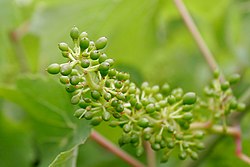Annual growth cycle of grapevines

The annual growth cycle of grapevines is the process that takes place in the vineyard each year, beginning with
Bud break

The grape starts its annual growth cycle in the spring with bud break. In the Northern Hemisphere, this stage begins around March while in the
Tiny buds on the vine start to swell and eventually shoots begin to grow from the buds. Buds are the small part of the vine that rest between the vine's stem and the petiole (leaf stem). Inside the buds contain usually three primordial shoots. These buds appear in the summer of previous growth cycle green and covered in scales. During winter dormancy they turn brown until the spring when the vine begins the process of bud break and the first sign of green in the vineyard emerges in the form of tiny shoots.[3] The energy to facilitate this growth comes from reserves of carbohydrate stored in roots and wood of the vine from the last growth cycle. Eventually the shoots sprout tiny leaves that can begin the process of photosynthesis, producing the energy to accelerate growth. In warm climates, after about 4 weeks the growth of the shoots starts to rapidly accelerate with the shoots growing in length an average of 3 cm (1.2 in) a day.[1]
In temperate climates, where temperatures can reach above 10 °C (50 °F) in mid-winter, some early budding varieties (such as Chardonnay) can be at risk of premature bud break. This is a potential viticultural hazard in places like the Margaret River region of Western Australia where warm currents from the Indian Ocean can coax Chardonnay vines to prematurely bud in the mid-winter month of July. After bud break, the young shoots are very vulnerable to frost damage with vineyard managers going to great lengths to protect the fragile shoots should temperatures dramatically drop below freezing. This can include setting up heaters or wind circulators in the vineyard to keep cold air from settling on the vines.[3]
Flowering

Depending on temperatures, 40–80 days after bud break the process of flowering begins with small flower clusters resembling buttons appearing on the tips of the young shoots. Flowering occurs when average daily temperatures stay between 15 and 20 °C (59 and 68 °F), which in the Northern Hemisphere wine regions is generally around May and for the Southern Hemisphere regions around November. A few weeks after the initial clusters appear, the flowers start to grow in size with individual flowers becoming observable.
Most cultivated
At the beginning of the flowering process the only part that is visible is the fused cap of petals known as the
Fruit set

The stage of fruit set follows flowering almost immediately, when the fertilized flower begins to develop a seed and grape berry to protect the seed. In the Northern Hemisphere, this normally takes place in May and in the Southern Hemisphere in November.
Veraison

Following fruit set, the grape berries are green and hard to the touch. They have very little
The onset of veraison does not occur uniformly among all berries. Typically the berries and clusters that are most exposed to warmth, on the outer extents of the
After harvest

In the vineyard, the antepenultimate event is the
Following the harvest, the vines continue the process of photosynthesis, creating carbohydrate reserves to store in the vine's roots and trunks. It will continue doing this until an appropriate level of reserves have been stored. At that point the chlorophyll in the leaves begins to break down and the leaves change color from green to yellow. Following the first frost the leaves begin to fall as the vine starts to enter its winter dormancy period. The following spring, the cycle begins again.[1]
See also
References
- ^ ISBN 0-19-860990-6
- ISBN 0-19-860990-6
- ^ ISBN 0-19-860990-6
- ^ ISBN 0-19-860990-6
- ^ Reisch, Bruce; Stewart, Philip (2001). "Grape Breeding Procedures". Cornell Grape Breeding. Retrieved 16 November 2015.
- ISBN 0-19-860990-6
- ISBN 0-19-860990-6
- ^ ISBN 0-19-860990-6
External links
- Annual Cycle of the Grapevine Archived 2015-10-15 at the Wayback Machine
- Stages of Grape Berry Development Archived 2015-10-15 at the Wayback Machine, information from Cooperative Extension
